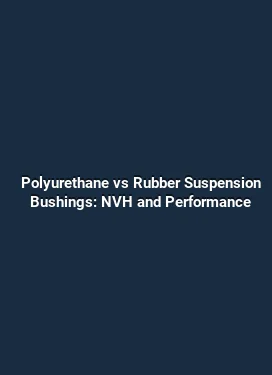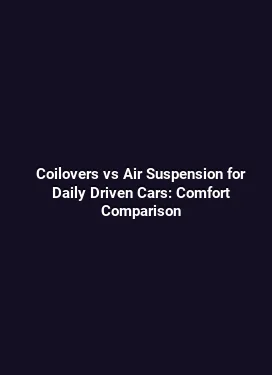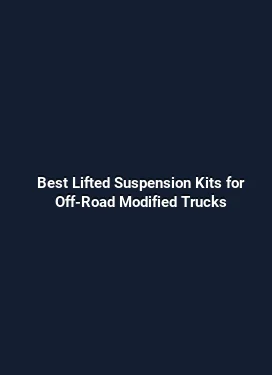Best Budget Coilover Setup Under $1200 for Street and Track Use
Suspension and handling are foundational to a vehicle's alignment with driver intent. When working with a limited budget, selecting a coilover system that balances ride quality, adjustability, and durability becomes essential. This guide dives into practical, tested approaches to building a capable street and track-ready coilover setup under $1200, focusing on real-world tuning strategies, part compatibility, and long-term maintenance. By exploring various models, damper characteristics, spring rates, and alignment considerations, enthusiasts can achieve meaningful performance gains without compromising daily drivability.
Understanding Coilovers on a Budget

Coilovers combine spring and damper into a single unit, offering adjustability in ride height and often damping. The budget segment emphasizes value: robust construction, predictable handling, and serviceability rather than boutique valving. When evaluating options under $1200, there are several common design choices: monotube versus twin-tube dampers, piston sizes and valving options, adjustable rebound and compression ranges, and the availability of camber plates or lower mount options for flange-height adjustments. The right combination depends on vehicle weight, cornering loads, tire choice, and how aggressively the driver intends to push the car on the track.
Key factors affect how a budget coilover feels and performs on the road and the track. Damper quality and consistency across the travel range influence initial turn-in, mid-corner stability, and exit grip. Spring rate directly affects how the chassis rolls under load, while ride height adjustment influences suspension geometry and tire contact patch. A well-rounded setup preserves daily comfort, yet responds predictably at the limit when warmed tires deliver grip. In practice, a balanced approach involves selecting a reputable budget line, pairing it with appropriate spring rates, and tuning alignment and tire pressures to the car and driver.
Key Variables That Affect Handling and Comfort
Translating a budget coilover purchase into real-world performance requires attention to specific variables. The following elements often determine the perceived quality of a setup, especially when resources are constrained.
Damper Characteristic and Consistency: Monotube designs in budget lines may offer predictable damping, but consistency across cycles is crucial. Drivers notice abruptness or dithering as the suspension moves through small bumps or rapid steering inputs. Look for dampers with adequate oil flow and piston area to handle both street pothole mitigation and track transitions without fading. Consistent damping translates to repeatable lap times and a more forgiving ride on rough pavement.
Spring Rate and Tuning Range: The spring rate must align with vehicle weight, tire footprint, and intended use. On street-driven cars, a slightly stiffer setup reduces body roll without creating a harsh ride. For track use, progressive or two-way adjustability may help. In budget options, initial springs are often paired with dampers that offer limited valving adjustments, so selecting the correct nominal rate is vital. A common starting point is a 6-8% increase over stock for street-oriented setups, with track-focused configurations nudging higher depending on weight distribution and tire choice.
Ride Height and Geometry: Lowering a vehicle alters roll centers, bump steer, and static camber. Budget coilovers may include camber adjustments at the top mounts, which is valuable for aligning tire contact patches. However, excessive lowering can stress bushings and destabilize ride quality. A measured drop, paired with an accurate alignment, helps maintain steering precision without compromising compliance over imperfect road surfaces.
Tire and Wheel Interaction: The tire is the final control surface. A budget coilover system should permit enough damping tuning to keep the tire in contact with the road over varied surfaces. Ensure wheel offsets and tire sizes are compatible with the chosen ride height to avoid rubbing and to maintain proper steering feel. Temperature management, especially on the track, matters: stiffer setups can overheat tires quickly, diminishing grip and increasing wear.
Top Budget Coilovers Under $1200: Models and Setups
Several manufacturers offer complete coilover packages in the sub-$1200 bracket that are suitable for street use and occasional track days. The following options are representative of the value and performance available today. Each model has its strengths, and practical setup tips follow to help readers tailor the system to their car and goals.
BC Racing BR Series (Budget Street/Track)

BC Racing’s BR Series is widely regarded as one of the most versatile budget coilover lines. The BR series typically features five-way adjustable dampers, ride height adjustment, and camber adjustment on the top mounts for front setups. A full kit commonly falls within the $900–$1200 range depending on vehicle fitment. Pros include broad availability, strong aftermarket support, and relatively easy installation. Cons may include stiffer initial damping feel on rough pavement and a damping curve that benefits from fine-tuning for specific track surfaces. For street use, aim for a balanced damping setting that minimizes mid-corner oscillation while retaining a compliant ride over bumps. Track setups should focus on more aggressive rebound adjustment to control body motion and tire motion under high cornering loads.
Setup tips: - Start with a conservative spring rate that suits your weight and tire size, then tune dampers to reduce wheel hop. - Use calibrated alignment settings to maintain tire contact patch when lowering the ride height by a modest amount. - Confirm bolt-on components, including pillow ball or rubber bushings, to match desired steering response and feedback.
FK Street Coilovers (Entry-Level Performance)
FK Automotive’s Street coilovers offer an approachable option for drivers seeking better handling without sacrificing street comfort. They often provide independent damping adjustments and a straightforward installation process. The price point often aligns with under-$1200 kits, depending on the vehicle platform. The damping range tends to favor a more compliant early travel with sufficient support through mid-stroke, which helps with daily usability but may require extra attention to adjust for track sessions. FK’s kits can be a good match for car enthusiasts who want an easy path to noticeable improvement without an exhaustive tuning process.
Setup tips: - For street use, prioritize a modest drop and balanced damping to preserve ride quality. - On the track, increase rebound to reduce body roll and aim for a stable chassis response through transitions. - Ensure compatibility with available camber plates or top mounts to maintain proper tire contact under load.
Ksport Kontrol Pro Series (All-Round Budget Performance)
The Ksport Kontrol Pro line is popular among budget-conscious enthusiasts who want adjustable dampers and ride height. This family of coilovers typically includes damping adjustment at the highway range, with a robust mount and solid construction. While not all fitments are identical across models, the Kontrol Pro kits frequently sit near the $1000–$1200 mark and provide a good blend of street comfort and track-ready performance. The main advantage is the broad range of vehicle compatibility and a straightforward tuning approach. The main trade-off can be the stiffness of the damping curve on rough roads if the chosen spring rate is too aggressive for daily driving.
Setup tips: - Choose a spring rate aligned with daily driving comfort first, then adjust damping to refine high-speed stability. - Use progressive alignment settings and consider front camber optimization to maximize grip without excessive tire wear.
Qahor Racing and Other Emerging Brands (Value-Oriented Options)
In the budget bracket, several lesser-known brands offer compelling packages. These options often bring competitive pricing, with primary value coming from factory fitment convenience and a strong warranty. While testing may vary by batch, many of these coilovers provide solid linear damping curves and simple installation. They are especially appealing to track enthusiasts who need a reliable upgrade for a weekend warrior without breaking the bank. The caution with emerging brands is ensuring parts availability, service support, and compatibility with chosen tires and wheels.
Setup tips: - Prioritize warranty and service access when choosing a model. - Verify available rebound/compression adjustments and verify alignment compatibility for your vehicle.
Practical Setup Guidelines for Street and Track Readiness
Translating a budget coilover purchase into a practical, well-rounded setup requires a methodical approach. The following guidelines help balance daily usability with track performance, maximizing the value of a cost-conscious investment.
Tire Strategy and Pressure Management: Start with the recommended tire pressures for your chosen tire size and compound. On street days, run a pressure that keeps the tire within a comfortable operating window. As you transition to track sessions, adjust pressures to achieve balanced grip across corners, monitoring tire temps to avoid overheating. Consistency across tires is crucial for predictable handling, especially when damping is dialed in for track use.
Alignment Precision: A well-tuned alignment complements the damping range of budget coilovers. Focus on achieving a balanced camber and toe that maximize tire contact patch during cornering without inducing excessive wear. A slight negative camber on the front axle can dramatically improve steering grip, while rear camber settings influence stability under power and braking. Track-focused alignment often requires more negative front camber and carefully tuned rear toe to control push or instability at the limit.
Damping Tuning Strategy: With budget dampers, a methodical approach to damping adjustments yields meaningful gains. Start with a baseline that minimizes mid-corner oscillations while preserving ride quality over rough roads. For street use, avoid extreme damping values that translate into a harsh ride. For track use, progressively increase rebound to dampen chassis motion during transitions, but monitor for over-damping that suppresses tire feel and reduces steering feedback.
Ride Height and Weight Distribution: Lowering the car affects weight transfer and roll behavior. Make small, incremental drops and re-check alignment and tire clearance. A well-balanced setup maintains adequate bump travel to absorb road irregularities while preserving predictable cornering behavior. If the weight distribution shifts significantly due to modifications, recalculate corner weights and adjust spring rates accordingly to maintain neutral handling characteristics.
Maintenance and Longevity: Budget coilovers still require periodic service. Inspect dampers for leaks, check mounting hardware for play, and verify spring seats and collars for smooth operation. Regularly cleaning the bodies and applying appropriate protective coatings helps extend the life of the units, especially in climates with road salt or heavy moisture. A disciplined maintenance routine keeps performance consistent and reduces the chance of component failure during track sessions.
Tuning Case Studies: Real-World Scenarios
Examining typical vehicle platforms helps illustrate how to apply the principles above. Consider a compact rear-wheel-drive sedan used for weekend track days and daily driving. With a BC Racing BR Series kit in a moderate height reduction, the aim is to balance front grip with rear stability. A 1-2-step increase in rebound stiffness helps control nose-diving under braking, while a small rear toe adjustment reduces understeer during entry. The result is a chassis that communicates with the driver through consistent, stable steering.
In another scenario, a front-wheel-drive hatchback used primarily on the street but occasionally on track days benefits from a slightly stiffer front spring rate to reduce wheel hop without compromising ride comfort. An FK Street coilover with careful damping calibration can deliver predictable feedback through corners while keeping harshness away from daily commutes. The key is to avoid over-damping that masks tire grip, enabling the driver to feel tire temperature and adhesion limits during spirited driving.
Final Considerations for Selecting and Using Budget Coilovers
Choosing the best budget coilover setup involves considering vehicle dynamics, tire strategy, and the driving environment. The most effective approach is to pick a system with a good reputation for build quality, compatibility with your vehicle, and a damping range that allows both street comfort and track confidence. Remember that the coilover kit is part of a larger suspension ecosystem, including sway bars, end links, bushings, and alignment. A holistic view ensures the car remains predictable across a wide range of speeds and road conditions while preserving tire life and safety.






